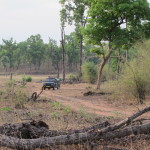
We were losing the light.
In the complex array of regulations under which Bandhavgarh National Park operates, the jeeps that take visitors on safaris start at 4pm and must be out the gate by 7pm, promptly. Otherwise, drivers and guides are fined or fired.
But we had not yet seen a tiger. Tigers are the main attraction, if not the ONLY attraction for most who come here. Middle class Indians in particular, we’re told, want to see no other wildlife, nor photograph anything else with their expensive cameras, despite the beauty of this preserve and the many, many other animals, birds and plant-life you can see here.
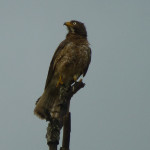
With respect to tigers, anyway, we had been particularly unlucky, not just on this safari, but on the three preceding safaris during our two day stay. We had toured the least likely section of the park in the morning of the first day, Khitauli, and indeed saw no tigers even though morning safaris last four hours from 5 to 9:15 precisely. But we knew we had three more to go in the much more likely prowling grounds of Magdhi. The third area, Tala, is renowned for its hilly terrain and historically good sightings, so it’s the most popular. We had no chance of booking that even a month ahead.
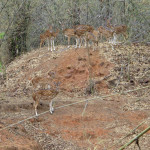
But Kithauli proved to be a very exciting place for us. It was mostly flat compared to the others, and more thinly forested with bamboo, semi-deciduous trees and others.
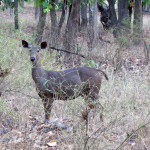
So we were able to see a great number of mammals on the loose – spotted deer, sambal, nilgai antelope, mongoose,. And we used our binoculars frequently to spot twenty-five or so bird species new to us in India, but fortunately well-known to our guides.
So, OK, no problem if a tiger didn’t appear. We were headed to Magdhi that afternoon.
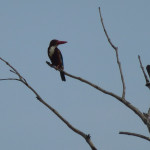
And we knew that an Indian couple from Delhi who were staying in Skay’s Camp with us had already spotted a tiger there. But our afternoon was unsuccessful as well, tiger-wise. We saw 15 to 20 more unfamiliar birds and sighted wild boar and jackals, across much more diverse terrain, plus we just missed seeing a leopard.
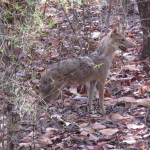
But the weather had turned, with a set of pre-monsoon showers, just enough to keep the big cats out of sight. Like a house cat, they don’t like to get themselves and particularly their paws wet. Nor do they need to come down to the watering holes when there are impromptu rain-filled hollows everywhere.

Over dinner that evening, our hosts, who had lived here nearly twenty years, schooled us further about the tigers. They’ve not only seen about all the tigers around, but Satyendra has photographed and Kay has drawn them too. Bandhavgarh is home to about 65 tigers altogether, all of whom they had charted in a family tree on the dining room wall, hung amid his many photographs.
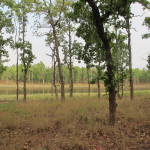
With the weather still threatening outside, we became fairly saturated with all things tigerish – not just their dislike of rain. We learned how the females establish a den, while the males roam a broader territory. She hunts once a week, or every two to three days if hungry mouths demand, even daily as the cubs grow. She breeds every two to three years. One female whose area was in Magdhi had three cubs, a male and two females. Those two were being shoved out of protective parenting now that she was pregnant again, but it wasn’t clear where they might be roaming.
By and large, the villagers living adjacent to the preserve have little problem with the tigers though their cows are good prey, perhaps even sacrificed up for the compensation the state offers. Yet the villagers continue to poach on trees and territory, bit by bit threatening the habitat.
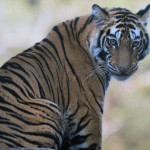
Tales of close encounters abound, with particular zest in stories involving locals. There was the one about a local motorcyclist who was rumbling along the dusty roads and found himself being chased by a tiger. Maneuvering the rutted road, he slid out on the cycle. Looking up, he and the tiger stared at each other about 10 meters apart. He stood up slowly, raised the cycle and then, acting less like prey, walked – not drove – away. Or the story of the gate guard, who greets visitors with “Hare krishna. Hare Rama. Asalaam alleikem.” He had always been petrified of tigers, but had to go through the park regularly. One day he and our host were buzzing along park roads when three mature cubs came up to them. They stopped because the tigers were blocking the way. As our host took photos, the guard slipped down onto the floor of the jeep, pleading for them to drive off. Our host invited him to step out instead.
So, with all this tiger-ness, we were ready; we knew we would soon be face to face with a tiger. How could we miss?
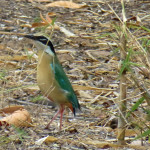
The next morning, however, dampened our spirits as clouds gathered thickly and rain fell once more, for only 15 minutes perhaps, but enough for puddles to form everywhere. The cooler air meant less thirst as well, so even the deer seemed to dissolve out of sight. At least one tiger had been sighted briefly in the morning, we found out, but not where we were.
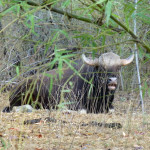
We tried to stay interested in the other animals – several new birds; close-up encounters with the misnamed Indian bison, the gaur, surely the model for the Wall Street bull statue; the cutest mother and child Hanuman Langur monkeys on a tree by the road, long tails hanging to the ground. But, as our four hours ticked away, we couln’t help but be disappointed.
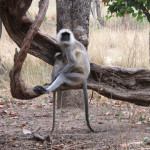
At lunchtime, the good fortune of our fellow guests helped our mood, though it was tinged with envy. They had visited Tala the same morning, where rain had not fallen, and came upon a tiger in the road who sat for a while, wandered away and then wandered back in front of them. And yes, those were some really nice pictures they took.
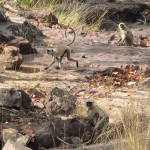
That afternoon, moreover, the weather was perfect. Since the morning, the sun had taken control; it was hot and it was dry. Our top notch crew assembled: Satyendra with his camera; a different guide who knew where sightings had occurred, and seemed to be able to sniff out tigers; and our driver, who could steer the rutted roads with ease and still spot tiny 20 centimeter birds in the distance.
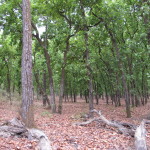
Soon after the starting gate, we saw a difference. Larger herds of deer were everywhere; a family of wild boar and a trio of gaur wandered near us. A good sign, we felt. We drove further and further into the territory, aiming first where the tiger had been seen in the morning, then in the plains by a watering hole below a ridge where another was thought to be ranging. Nothing.
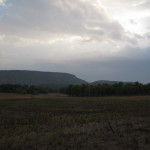
Around 6pm, our experts heard an alarm call from a sambal, a trumpeting bleat we too had managed to get out of another sambal by surprising him. We shifted our position to intercept the trail the tiger might be taking, then circled around the area. Other jeeps appeared and shifted to where they thought the trail might be. Nothing. We heard thunder and noticed that sky had begun to darken.

We started to work our way back to the gate, checking the usual trails and watering places along the way. Another sambal alarm sounded faintly, so we waited at a crossroads for 10 minutes. Nothing but a few drops of rain.
6:45 and we were taking the last turns toward the gate, through a dark, dense stand of trees. We had given up. Fourteen hours of safaris in tiger country and not one tiger.
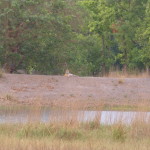
Except that one.
A hundred meters ahead of us another jeep had stopped; everyone was standing and pointing. We hurried up to them. Through the trees, across a meadow and very far away, there he was – darkly striped and oddly bright orange in that dusty, dusky green space. Sublimely indifferent, he lay at the very top of the flat bank above a man-made reservoir – within a few meters of the main road outside the park.
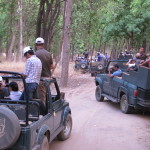
All the other jeeps packed in. Cameras blinked; binoculars brought his majesty close to our eyes. He looked around. He looked over at us. He sat still. After ten minutes, he started to move to our right.
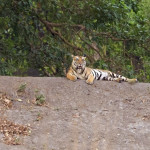
The jeeps flew after him, partly to be out the gate by 7pm and partly to see if his walking path came near the main road. But he had disappeared.
Not face to face, but we had seen a tiger – burning bright in the darkness of the light – at Bandhavgarh.
[Tiger photos courtesy of Satyendra Tiwari]
(Also, for more pictures from India, CLICK HERE to view the slideshow at the end of the India itinerary page.)


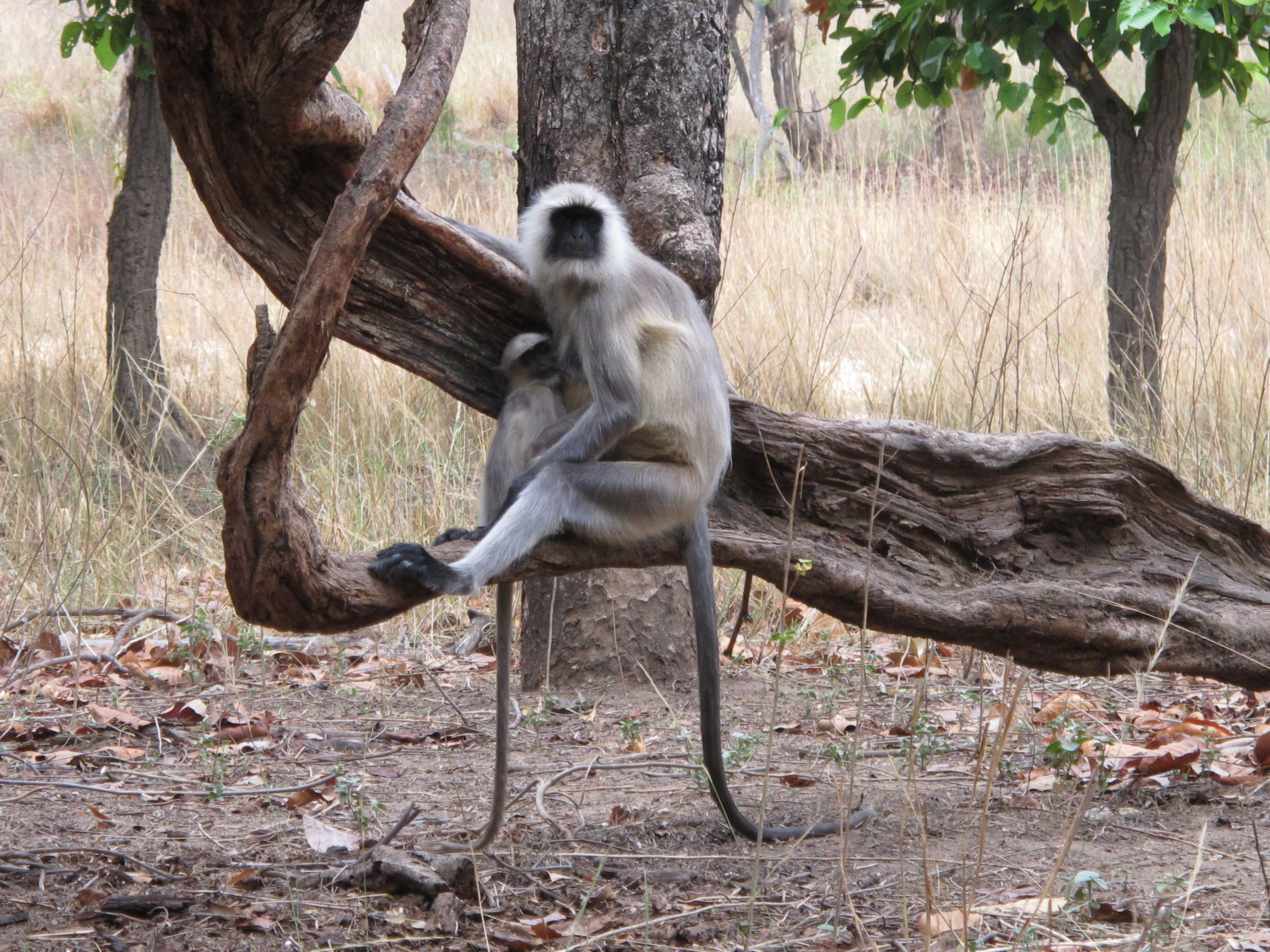

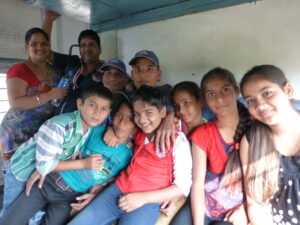
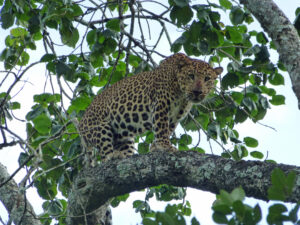
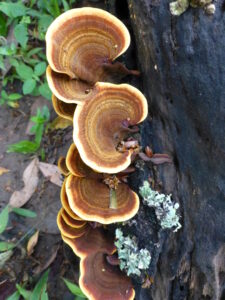
The tiger reveals more about man than himself…. Sounds like it was still worth the hunt!
Love the nature pix….I set the wetlands image as my background. Wish I was there, such cool birds…